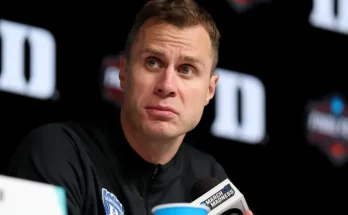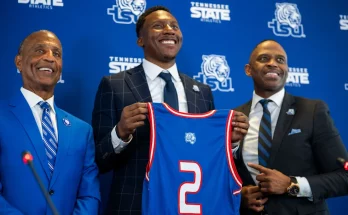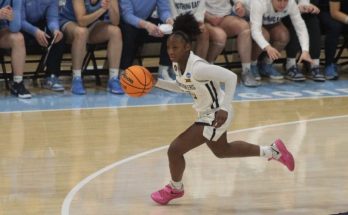The Detroit Lions have become one of the NFL’s most intriguing rebuild stories—transforming from a perennial bottom-feeder into a legitimate contender with a fiery head coach, a bruising identity, and a roster that’s beginning to reflect its city’s grit. But even with their recent resurgence, one area remains in flux: the secondary. So when Dane Brugler’s latest mock draft dropped with the Lions selecting a cornerback out of Kentucky, many fans paused. Not because the position doesn’t make sense, but because the specific player was a surprise to many who’ve followed the pre-draft narrative.
In the mock, the Lions selected Kentucky cornerback Maxwell Hairston in the late first round, passing over several higher-ranked prospects in the process. It’s a bold move on the surface. Hairston hasn’t been a constant in first-round conversations—at least not among mainstream analysts. However, if there’s anything this front office has shown since Brad Holmes and Dan Campbell took over, it’s a willingness to think differently and place a premium on traits, toughness, and fit over hype.
Hairston, a 6-foot-1, 181-pound cover man, had a breakout 2023 campaign with the Wildcats. After limited playing time early in his college career, he exploded onto the scene last season with six interceptions, two of which he returned for touchdowns. He also added a forced fumble, 12 pass breakups, and showcased a nose for the football that made offensive coordinators think twice about throwing in his direction. What truly caught Brugler’s eye, and evidently Detroit’s in this mock, is Hairston’s combination of length, fluid hips, and instincts in zone coverage—traits that perfectly match what defensive coordinator Aaron Glenn wants out of his boundary defenders.
For Detroit, the timing of this pick also tells a story. They’ve made several moves to patch their secondary over the past two years. Last season, they added Cam Sutton, C.J. Gardner-Johnson, and Emmanuel Moseley in free agency, and drafted Brian Branch out of Alabama, who proved to be a steal in the second round. Branch figures to be a long-term solution in the nickel, but the Lions’ boundary cornerback situation is far from settled. Sutton struggled down the stretch in 2024, and Moseley can’t seem to stay healthy. Trading for Carlton Davis III this offseason offered a short-term answer, but he’s entering a contract year. That opens the door for a young, athletic, scheme-versatile corner like Hairston to step in and grow into a starting role quickly—without the immediate pressure of guarding the opponent’s top receiver from day one.
Still, the selection drew mixed reactions among fans and draft analysts alike. Some questioned whether Detroit reached too far for a player who might have been available in the second round. Others pointed out that in a draft class relatively thin at cornerback after the top two or three names, reaching for a scheme fit might be more acceptable—especially for a team like the Lions, whose roster is now good enough to draft for specific roles rather than just raw talent.
But if you look deeper, Hairston’s tape may justify the gamble. He’s an instinctual corner who plays with anticipation, rarely bites on double moves, and shows a strong understanding of route combinations. At Kentucky, he regularly drew the assignment of covering the SEC’s best wideouts, and more often than not, held his own. His ball production speaks volumes—interceptions don’t come easy in that conference, especially not at his rate. He’s not just a cover man either; he’s aggressive in run support and willing to tackle, a trait Campbell and Glenn openly covet.
Moreover, Brugler’s inclusion of Hairston in the first round may not be as outlandish as it seems. The respected draft analyst, known for his extensive breakdowns and deep research, noted that Hairston had been generating quiet buzz in NFL circles throughout the pre-draft process. He reportedly interviewed well during team meetings at the NFL Combine and posted strong measurables during Kentucky’s pro day, including a sub-4.4 40-yard dash, a 38-inch vertical, and impressive agility scores in the shuttle and 3-cone drills. Those numbers back up the explosiveness and fluidity seen on tape.
For the Lions, adding Hairston continues a trend. This is a team that has prioritized physicality, competitiveness, and character in its recent draft history. Look at the types of players Detroit has brought in: Aidan Hutchinson, Brian Branch, Jack Campbell, and Penei Sewell are all tone-setters. They may not have been consensus top picks at their positions when selected, but they’ve become culture drivers. If Detroit views Hairston in that same light—as a young defender who can elevate the unit’s energy, while developing into a shutdown presence—then it’s a pick that makes more sense than the mocks might suggest.
It also aligns with how Holmes and Campbell have operated in past drafts. They’re not concerned about “winning” the mock draft game. They’re focused on adding players who embody the team’s identity. In fact, one could argue this is what has made their rebuild so effective and so quick. They don’t chase flash—they build from the trenches, prioritize mental toughness, and let the locker room culture filter out anyone who doesn’t buy in. In that framework, Hairston fits like a glove.
Another aspect worth noting is Detroit’s increasing reliance on young players in key roles. The Lions have made it clear they aren’t afraid to throw rookies into the fire—just ask Jahmyr Gibbs and Sam LaPorta. If Hairston shows in training camp that he can process quickly and hold his own against NFL receivers, don’t be surprised if he finds himself on the field early, especially with uncertainty lingering around Moseley’s recovery and Sutton’s future.
In a broader sense, this selection also signals a shift in how the Lions view their defensive backfield. For much of the past decade, it’s been a weakness—an area patched up with temporary solutions and late-round dart throws. But in today’s NFL, where offenses are more pass-heavy than ever, you can’t afford to be average in coverage. The Lions are recognizing that and, in turn, committing to developing young, high-upside talent who can grow with the rest of this promising core.
Some might argue that Detroit should’ve prioritized an edge rusher or interior defensive lineman with this pick, considering how important pass rush is in today’s league. But the truth is, coverage and pass rush are interconnected. If you can’t cover long enough for your pass rush to get home, even the best front four becomes irrelevant. Adding a ball-hawk like Hairston helps tighten coverage windows, increases the odds of turnovers, and provides Glenn with more flexibility in disguising blitzes and coverages.
Of course, nothing is certain until the draft plays out, and the Lions could go in several directions depending on how the board falls. But Brugler’s mock gives fans a potential glimpse into the kind of calculated risk Detroit might be willing to take. Hairston isn’t the household name many expected to see in the first round, but neither was Brian Branch last year. And as the Lions have shown repeatedly, they’re more than happy to zig when everyone else zags—as long as it gets them closer to a championship.
Ultimately, the pick of Maxwell Hairston might not make headlines nationally. It won’t be debated the way quarterback selections or top-five picks are. But in Detroit, among a fanbase that’s learned to trust this regime’s process, it could very well be remembered as one of the quietest home runs of the draft. Time will tell if Hairston develops into the impact starter the Lions believe he can be. But for now, Detroit’s decision to target a high-upside corner with SEC pedigree and a chip on his shoulder looks like yet another piece in the puzzle of a team inching ever closer to its Super Bowl dreams.



